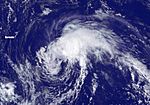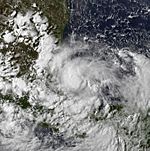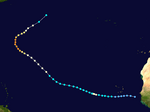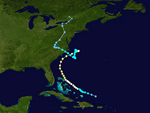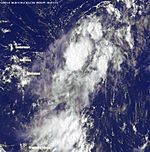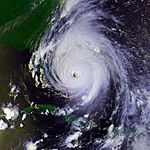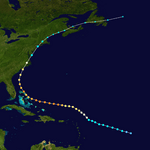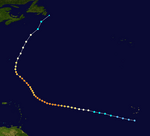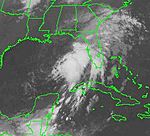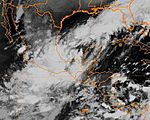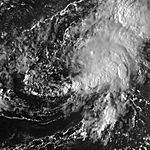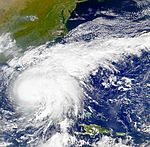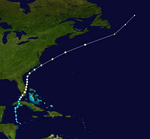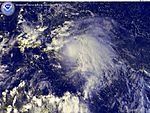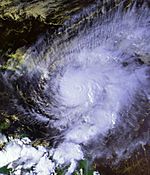Quick facts for kids
1999 Atlantic hurricane season
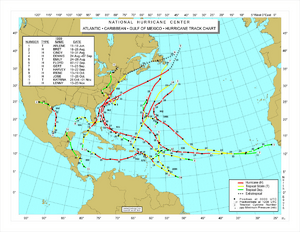 |
| Season summary map |
| First storm formed |
June 11, 1999 |
| Last storm dissipated |
November 23, 1999 |
| Strongest storm |
Floyd – 921 mbar (hPa) (27.21 inHg), 155 mph (250 km/h) |
| Total storms |
12 |
| Hurricanes |
8 |
| Major hurricanes (Cat. 3+) |
5 |
| Total fatalities |
465 |
| Total damage |
$5.9 billion (1999 USD) |
Atlantic hurricane seasons
1997, 1998, 1999, 2000, 2001 |
The 1999 Atlantic hurricane season was a time when tropical storms and hurricanes formed in the Atlantic Ocean. It officially started on June 1, 1999, and ended on November 30, 1999. Even though these are the official dates, storms can sometimes form outside this period.
This season had a normal amount of activity. There were 12 named storms, and 8 of them grew into hurricanes. Five of these hurricanes became very strong, known as major hurricanes. While it wasn't the deadliest season, it did cause a lot of damage.
Storms of 1999
Tropical Storm Arlene
| Tropical storm (SSHS) |
|
|
| Duration |
June 11 – June 18 |
| Intensity |
60 mph (95 km/h) (1-min), 1006 mbar (hPa) |
The first storm of the season, Tropical Storm Arlene, began on June 11. It started as a tropical depression and then became a tropical storm. Arlene passed about 115 miles away from Bermuda. Strong winds in the atmosphere, called wind shear, caused Arlene to weaken and disappear by June 18.
Tropical Depression Two
| Tropical depression (SSHS) |
|
|
| Duration |
July 2 – July 3 |
| Intensity |
35 mph (55 km/h) (1-min), 1004 mbar (hPa) |
Tropical Depression Two formed on July 2. It moved towards land and hit Tecolutla, Mexico, early the next morning. The depression faded away just a few hours after reaching land. There were no reports of damage in Mexico from this storm.
Hurricane Bret
| Category 4 hurricane (SSHS) |
|
|
| Duration |
August 18 – August 25 |
| Intensity |
145 mph (230 km/h) (1-min), 944 mbar (hPa) |
Hurricane Bret started as Tropical Depression Three on August 18. It moved north over the Gulf of Mexico. As it traveled, it became a tropical storm and then a hurricane. Bret then turned a little to the west. It made landfall on Padre Island and later on the mainland of Texas. The hurricane weakened and died over land on August 25. Hurricane Bret caused 7 deaths and about $15 million in damage. It didn't cause more damage because it hit an area with few people.
Hurricane Cindy
| Category 4 hurricane (SSHS) |
|
|
| Duration |
August 19 – August 31 |
| Intensity |
140 mph (220 km/h) (1-min), 942 mbar (hPa) |
Cindy began near Africa on August 19. It became a tropical storm the next day, August 20. The storm quickly grew into a hurricane. Then it weakened back to a tropical storm. A few days later, it became a hurricane again as conditions improved. At its strongest, Hurricane Cindy had winds of 140 miles per hour. This made it a Category 4 hurricane. It moved northeast and disappeared on August 31. Hurricane Cindy stayed far from land for its entire life.
Hurricane Dennis
| Category 2 hurricane (SSHS) |
|
|
| Duration |
August 24 – September 9 |
| Intensity |
105 mph (165 km/h) (1-min), 962 mbar (hPa) |
Tropical Depression Four formed on August 24. It soon became a tropical storm and was named "Dennis." Tropical Storm Dennis grew into a hurricane as it moved near The Bahamas. It then moved close to North Carolina and South Carolina. Dennis weakened and moved in an unusual way. It eventually made landfall in North Carolina on September 5. By then, it was a strong tropical storm. Dennis died on September 9 over New York.
Tropical Storm Emily
| Tropical storm (SSHS) |
|
|
| Duration |
August 24 – August 28 |
| Intensity |
50 mph (85 km/h) (1-min), 1004 mbar (hPa) |
Tropical Storm Emily started on August 24. It traveled almost directly north for most of its time. Strong winds from Hurricane Cindy caused Emily to weaken and disappear on August 28.
Tropical Depression Seven
| Tropical depression (SSHS) |
|
|
| Duration |
September 5 – September 7 |
| Intensity |
35 mph (55 km/h) (1-min), 1006 mbar (hPa) |
Tropical Depression Seven formed off the coast of Mexico on September 5. On September 6, it moved onto land in Mexico. The depression then died out the very next day.
Hurricane Floyd
| Category 4 hurricane (SSHS) |
|
|
| Duration |
September 7 – September 17 |
| Intensity |
155 mph (250 km/h) (1-min), 921 mbar (hPa) |
Hurricane Floyd was the strongest, most damaging, and deadliest hurricane of the 1999 season. At first, it looked like Floyd was heading for Florida as a powerful Category 4 hurricane. But instead of hitting Florida, Floyd struck North Carolina. It caused widespread flooding from North Carolina all the way up to some states in New England. Floyd left about $4.5 billion in damage from Florida to Maine. It also caused about 76 to 86 deaths in the United States. One person was also killed in The Bahamas.
Hurricane Gert
| Category 4 hurricane (SSHS) |
|
|
| Duration |
September 11 – September 23 |
| Intensity |
150 mph (240 km/h) (1-min), 930 mbar (hPa) |
A tropical depression began near Cape Verde on September 11. It quickly became a tropical storm and was named "Gert." By September 16, it had grown into a strong Category 4 hurricane. Hurricane Gert died out on September 23 near Newfoundland. Gert might have caused 2 deaths in Maine due to large waves.
Tropical Storm Harvey
| Tropical storm (SSHS) |
|
|
| Duration |
September 19 – September 22 |
| Intensity |
60 mph (95 km/h) (1-min), 994 mbar (hPa) |
Tropical Storm Harvey started as a depression in the Gulf of Mexico on September 19. It made landfall in Everglades, Florida, shortly before it disappeared. Harvey did not cause any deaths, but it did lead to about $15 million in damage.
Tropical Depression Eleven
| Tropical depression (SSHS) |
|
|
| Duration |
October 4 – October 6 |
| Intensity |
35 mph (55 km/h) (1-min), 1002 mbar (hPa) |
Tropical Depression Eleven was a weak storm that did not make landfall. However, it might have been the deadliest storm of 1999. The outer parts or what was left of the depression moved over Mexico. It is believed that this storm could have caused nearly 400 deaths.
Tropical Depression Twelve
| Tropical depression (SSHS) |
|
|
| Duration |
October 6 – October 8 |
| Intensity |
35 mph (55 km/h) (1-min), 1007 mbar (hPa) |
Tropical Depression Twelve formed on October 6. It moved northwest for its entire life. The depression faded away on October 8, without ever coming close to land.
Hurricane Irene
| Category 2 hurricane (SSHS) |
|
|
| Duration |
October 12 – October 19 |
| Intensity |
110 mph (175 km/h) (1-min), 958 mbar (hPa) |
Irene formed just north of Honduras on October 12. It moved north and crossed Cuba as a tropical storm. The next day, as a hurricane, it traveled over the Florida Keys and most of South Florida. It then moved north, getting close to North and South Carolina. Hurricane Irene became stronger as it moved. The hurricane moved very quickly as it left the United States. It died out on October 19, south of Newfoundland. This hurricane caused 18 deaths: 4 in Cuba and 14 in the United States. It also caused $800 million in damage.
Hurricane Jose
| Category 2 hurricane (SSHS) |
|
|
| Duration |
October 17 – October 25 |
| Intensity |
100 mph (155 km/h) (1-min), 979 mbar (hPa) |
Jose started on October 17 as a tropical depression. It moved northwest and soon became a tropical storm. Not long after, it grew into a hurricane. Hurricane Jose passed over the northern Lesser Antilles as a weak hurricane. The hurricane disappeared by October 25. As it passed over the islands, it caused $5 million in damage and led to 2 deaths.
Tropical Storm Katrina
| Tropical storm (SSHS) |
|
|
| Duration |
October 27 – November 1 |
| Intensity |
40 mph (65 km/h) (1-min), 999 mbar (hPa) |
Tropical Storm Katrina began on October 27 as a tropical depression. It became a tropical storm very shortly before hitting land in Puerto Cabezas, Nicaragua. Tropical Storm Katrina soon weakened back to a depression. As a depression, it made landfall in the Yucatán Peninsula. It died on November 1, just before it was about to enter the Gulf of Mexico. No one died, and there was not much damage from this storm.
Hurricane Lenny
| Category 4 hurricane (SSHS) |
|
|
| Duration |
November 13 – November 23 |
| Intensity |
155 mph (250 km/h) (1-min), 933 mbar (hPa) |
Hurricane Lenny was a very powerful hurricane for November. In fact, it was the strongest November hurricane ever recorded in the Atlantic Ocean. This hurricane traveled east across the Caribbean Sea. Later, it moved northeast, towards the northeastern Caribbean islands. It became much stronger very quickly, almost reaching Category 5 strength. On November 17, it made landfall in Saint Croix. Lenny died out on November 23. Hurricane Lenny caused 17 deaths and about $330 million in damage.
Storm Names Used in 1999
Below is a list of the names used for storms in 1999. Names that were not used are marked with gray. This list is the same as the one used in 1993.
- Arlene
- Bret
- Cindy
- Dennis
- Emily
- Floyd
- Gert
|
- Harvey
- Irene
- Jose
- Katrina
- Lenny
- Maria (unused)
- Nate (unused)
|
- Ophelia (unused)
- Philippe (unused)
- Rita (unused)
- Stan (unused)
- Tammy (unused)
- Vince (unused)
- Wilma (unused)
|
Retired Names
In the spring of 2000, two names from this season were "retired." This means they will never be used again for hurricanes in the Atlantic Ocean. These names were Floyd and Lenny. The names Franklin and Lee replaced them in the 2005 season.
|
Tropical cyclones of the 1999 Atlantic hurricane season
|
|
|
|
|
|
Images for kids
-
Hurricanes Floyd (left) and Gert (right) pictured on September 13
See also
 In Spanish: Temporada de huracanes en el Atlántico de 1999 para niños
In Spanish: Temporada de huracanes en el Atlántico de 1999 para niños

 In Spanish: Temporada de huracanes en el Atlántico de 1999 para niños
In Spanish: Temporada de huracanes en el Atlántico de 1999 para niños

